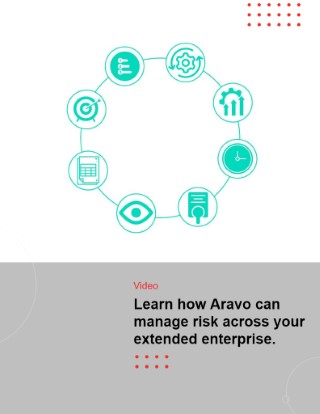Tom Garrubba on Six Ways Collaboration Can Enhance Your TPRM
February 5th, 2018
•
posted by Aravo
• Reading Time: 5 minutes
Collaboration is a term that makes people either cheer or wince. However, today collaboration is essential to be a successful third party risk manager – the discipline has moved well beyond administrative box-ticking. Now, a strong culture of collaboration can help create the right environment to foster TPRM program excellence, and drive real value for organizations.
If that sounds difficult to achieve, third party risk executives need to become aware that they are not “flying this plane alone,” says Tom Garrubba, Senior Director at Shared Assessments, a member-driven consortium that creates standards around outsourcing, including assessment questionnaires. “Remember, you have a pilot, a co-pilot, a navigator, flight attendants, baggage handlers and others.” All of these stakeholders need to be involved to make TPRM work – and to make it work better.
Below are Garrubba’s six key ways that collaboration can put the right wind into the sails of a TPRM program:
- Become involved in standardization programs. Standardization is on the rise, and will become best practice for firms over the next two or three years, says Garrubba. Programs such as Shared Assessments enable organizations to benefit from a substantial body of knowledge and understanding that has been built up over more than a decade. “When creating a third party risk assessment, there is no need to reinvent the wheel,” says Garrubba. “It is very likely that other organizations have run into similar challenges, or have comparable information needs about the vendors they work with.” Working with a well-known group means that an organization can trust the information and suggestions it is receiving. “Google,” Garrubba says, “is a less reliable source of ideas about what a third party assessment should be asking about.” Being part of a group can help when it comes to new requirements, too. Garrubba worked with the Shared Assessments’ Privacy Committee to develop the Shared Assessments GDPR Data Processor Privacy Toolkit, launched in December 2017. This Tool Kit provides guidance to help organizations conform to the European Union’s (EU) General Data Protection Regulation (GDPR) Article 28. The Tool Kit outlines what companies need to do to comply with this privacy-focused element of the regulation.
- Reach out to your regulators. Around the globe, regulators are beginning to put out more guidance and rules around third party risk. “The US regulators’ Federal Financial Institutions Examination Council (FFIEC) IT Examination Handbook Appendix J and Office of the Comptroller (OCC) 2013-29 provide a very user-friendly foundation for what third party risk best practice looks like,” says Garrubba. “You don’t have to have a lawyer sitting next to you to understand it. It’s really good guidance on what organizations should be doing.” These regulatory frameworks can provide an excellent starting point for third party risk programs, he says. The EU’s GDPR is also a good framework to understand what a company should be doing around data privacy. Organizations should make sure that, first of all, their programs are complying with all of the necessary rules that may impact them from around the globe, before moving on to enhance their program further. Secondly, a third party program manager can do to enhance the organization’s regulatory relationships is to “document, document, document!” says Garrubba. This gives the regulator the ability to see – quickly and easily – just how well the third party risk program is doing, and to take all of the organization’s efforts into consideration. “You are never going to hit 100% compliance; however, you can hit conformity,” says Garrubba. “Compliance is very black and white, either you have it or you don’t, there is not a lot of grey. There are some regulators who might throw in a touch of grey – that’s more in the lines of conformity, rather than compliance.”
- Bond with your board of directors. Third party risk programs need to have board support. “Otherwise,” says Garrubba, “they can become a paper tiger. If you do not have senior-level support, you are not going to have a successful program.” All policies and processes should be agreed, at least in principle, by senior management and the board – and should be actively promoted by them. As well, senior management and the board are sometimes needed to ensure business units comply with third party programs and the changes they may require. Says Garrubba, “You want to make sure that what you are doing is something that will go across the entire enterprise.” In return, the third party risk program should be sure it is supplying the board of directors and senior management with the information it wants and needs to think constructively about third party risk.
- Have coffee with internal audit, legal, compliance… When creating an assessment questionnaire, it’s important to work with all of the key stakeholders. Says Garrubba, “It’s important that they are on board with what you are doing and that they are helping you shape your questions.” Having several pairs of eyes vet a list of questions can help make sure that the language is clear and that it will achieve the answers needed. A close relationship with internal audit can be particularly fruitful, he says – often internal auditors can provide expertise on not only drafting questions but also analysing the answers.”
- Friend your vendors. “Why do organizations contract with a third party,” asks Garrubba. “Either because it is cheaper or because they don’t have the talent and the technology to do the process themselves.” This implies that a third party has wisdom it can bring to the relationship between the two organizations. “Organizations really should be treating third parties as a component within their organization – they are a partner, treat them like a partner,” he says. “Don’t treat them like a step brother or sister you cannot really stand.” The reality is that the third party may be able to share information that can help the organization, and they in turn may be running their own third party programs that you can learn from. Says Garrubba, “I’ve spoken with companies that have said their third parties made their own company stronger. They looked at what a third party was doing and said, ‘We should be doing this too.’” He also says he’s seen organizations give third parties extra business, to grow the relationship, as a result of benefitting from this kind of collaboration.
- Know your business. Having a good working relationship with the business units is essential, says Garrubba. He says that when he was in previous roles, he used to have coffees, lunches, and dinners with a wide range of internal stakeholders to find out what their upcoming projects were, and better understand the company’s overall business strategy and ability to execute. For example, these conversations often helped ensure that new business opportunities were analysed correctly, keeping in mind the company’s own operations and outsourcing needs for fulfilment. Sometimes, best practices from one business unit could be shared with others. Or a casual conversation can help both the business unit and third party risk feel comfortable that things are just “on track.” Having less formal give-and-take can make it easier to resolve challenges, when they occur, too.
In short, third party risk managers need to be sure they are actively collaborating across the business – and outside the business – to be successful today. Many firms are choosing to support this with a software solution, which can make collaboration easier – by providing a “single source of truth” for data, and a platform through which some key conversations, particularly around specific processes, can take place. Creating the right third party risk environment will enable the correct culture to take root and flourish.
Shared Assessments Senior Director, Tom Garrubba, is an experienced professional in IT risk and information controls, most recently in developing, maintaining, and consulting on third party risk (TPR) programs for Fortune 100 companies. His is an internationally recognized subject matter expert and top-rated speaker on third party risk.
Tom Garrubba
tom@santa-fe-group.com
(412) 720-4248
Tom Garrubba, Senior Director at Shared Assessments, is an internationally recognized subject matter expert, lecturer, and author on cyber and compliance risk, and is head instructor for the Certified Third-Party Risk Professional (CTPRP) program. Tom is an active blogger with various industry organizations including Shared Assessments, Risk.net, Government Health IT, ISACA, and the Huffington Post’s business section. Previously, Tom was Senior Privacy Manager at CVS Health where he instituted and managed their third-party assessment program. Tom has 20 years of experience in consulting on IT security, privacy, audit, and compliance in various industries. You can connect with him via LinkedIn.
Ensure your third parties align to your information security data, privacy, and network security requirements





